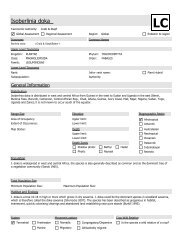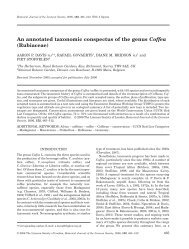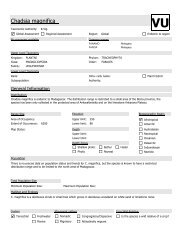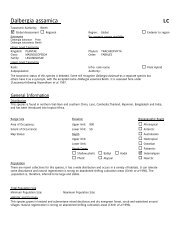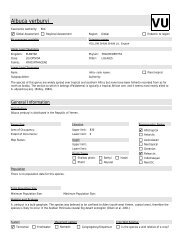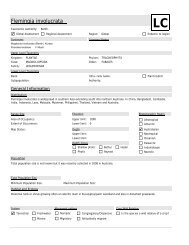Bauhinia wallichii.pdf - Sampled Red List Index for Plants
Bauhinia wallichii.pdf - Sampled Red List Index for Plants
Bauhinia wallichii.pdf - Sampled Red List Index for Plants
You also want an ePaper? Increase the reach of your titles
YUMPU automatically turns print PDFs into web optimized ePapers that Google loves.
<strong>Bauhinia</strong> <strong>wallichii</strong><br />
Taxonomic Authority: J.F.Macbr.<br />
Global Assessment Regional Region: Global Endemic to region<br />
Synonyms<br />
<strong>Bauhinia</strong><br />
<strong>Bauhinia</strong><br />
Phanera<br />
Phanera <strong>wallichii</strong><br />
(Benth.) Baker<br />
Merr.<br />
Benth.<br />
(J.F. Macbr.) Thoth.<br />
No common names available<br />
Upper Level Taxonomy<br />
Kingdom: PLANTAE<br />
Phylum: TRACHEOPHYTA<br />
Class: MAGNOLIOPSIDA Order: FABALES<br />
Family: LEGUMINOSAE-CAESALPINIOIDEAE<br />
Lower Level Taxonomy<br />
Rank: Infra- rank name: Plant Hybrid<br />
Subpopulation:<br />
Authority:<br />
General In<strong>for</strong>mation<br />
Distribution<br />
This species is recorded from Bangladesh, India, Myanmar, Yunnan in China and northern Vietnam.<br />
LC<br />
Range Size Elevation Biogeographic Realm<br />
Area of Occupancy: Upper limit: Afrotropical<br />
Extent of Occurrence: Lower limit: Antarctic<br />
Map Status: Depth Australasian<br />
Upper limit:<br />
Neotropical<br />
Lower limit:<br />
Oceanian<br />
Depth Zones<br />
Palearctic<br />
Shallow photic Bathyl Hadal Indomalayan<br />
Photic Abyssal Nearctic<br />
Population<br />
This species is poorly represented in collections (Larsen et al. 1980) and most herbarium specimens found are dated<br />
from the late 19th and early 20th century. This species has been recently reported as new to China (Zhang and Chen<br />
1996) and Thailand (Larsen 1999) and this support the view that it is under recorded.<br />
Total Population Size<br />
Minimum Population Size:<br />
Maximum Population Size:<br />
Habitat and Ecology<br />
This large perennial climber is found in hilly <strong>for</strong>ests and <strong>for</strong>est margins.<br />
System Movement pattern Crop Wild Relative<br />
Terrestrial Freshwater Nomadic Congregatory/Dispersive Is the species a wild relative of a crop?
Marine Migratory Altitudinally migrant<br />
Growth From<br />
Vines<br />
Definition<br />
Vines, lianas and creepers<br />
Threats<br />
The main threat to this species is the loss of its <strong>for</strong>est habitat. Forests in Vietnam and the hills of southern Yunnan have<br />
been degraded, cleared and fragmented (Carpenter et al. 2001). Much of the Brahmaputra valley semi-evergreen<br />
<strong>for</strong>ests has been cleared but some large blocks of habitat remain (Rawat 2001). The Mizoram-Manipur-Kachin rain <strong>for</strong>ests has<br />
large areas still intact (Wikramanayake and Tin Than 2001). The main threats are from logging and clearing <strong>for</strong> agriculture,<br />
particularly shifting cultivation.<br />
Past Present Future<br />
1 Habitat Loss/Degradation (human induced) <br />
1.1 Agriculture <br />
1.1.1 Crops <br />
1.1.1.1 Shifting Agriculture <br />
1.1.1.2 Small-holder farming <br />
1.3 Extraction <br />
1.3.3 Wood <br />
Conservation Measures<br />
There are no specific conservation measures in place <strong>for</strong> this species. It was not found in available lists of seed bank and<br />
botanic garden species. It is reported from the Mahananda Wildlife Sanctuary in West bengal but most records fall outside<br />
existing protected areas. Further research is needed to establish its current georaphic range as this species appears to be<br />
under-recorded. Also more in<strong>for</strong>mation is needed in relation to the current population status and trends and the specific<br />
habitat status and threats.<br />
In Place Needed<br />
3 Research actions <br />
3.2 Population numbers and range <br />
3.4 Habitat status <br />
3.5 Threats <br />
3.9 Trends/Monitoring <br />
4 Habitat and site-based actions <br />
4.4 Protected areas <br />
5 Species-based actions <br />
5.7 Ex situ conservation actions <br />
Countries of Occurrence<br />
Year Breeding<br />
PRESENCE<br />
ORIGIN<br />
Non- Passage Possibly Extinct Presence Native Introduced Re- Vagrant Origin<br />
Round Season breeding migrant extinct uncertain Introduced uncertain<br />
only season only<br />
Bangladesh <br />
China <br />
India <br />
Myanmar <br />
Viet Nam
Ecosystem Services<br />
Insufficient In<strong>for</strong>mation available<br />
Species provides no ecosystem services<br />
Species Utilisation<br />
Species is not utilised at all<br />
Purpose / Type of Use Subsistence National International<br />
7. Fuel <br />
Local inhabitants in Bangladesh use this plant <strong>for</strong> fuel (Rezia Khatun 2008).<br />
Trend in the level of wild offtake/harvest in relation to total wild population numbers over the last five years:<br />
Trend in the amount of offtake/harvest produced through domestication/cultivation over the last five years:<br />
CITES Not listed<br />
IUCN <strong>Red</strong> <strong>List</strong>ing<br />
<strong>Red</strong> <strong>List</strong> Assessment: (using 2001 IUCN system) Least Concern (LC)<br />
<strong>Red</strong> <strong>List</strong> Criteria:<br />
Date Last Seen (only <strong>for</strong> EX, EW or Possibly EX<br />
Is the species Possibly Extinct? Possibly Extinct Candidate? <br />
Rationale <strong>for</strong> the <strong>Red</strong> <strong>List</strong> Assessment<br />
The extent of occurrence (EOO) exceeds the critical threshold <strong>for</strong> a threatened category. The estimated area of<br />
occurrence (AOO) and inferred population also exceed the thresholds. It is assessed as Least concern (LC). However, the<br />
habitat of this species has threats and further research is needed to establish the current population status and trends. Also<br />
surveys are needed to confirm the current geographic range, as this species appears to be under-represented in collections.<br />
Reason(s) <strong>for</strong> Change in <strong>Red</strong> <strong>List</strong> Category from the Previous Assessment:<br />
Genuine Change Nongenuine Change No Change<br />
Genuine (recent) New in<strong>for</strong>mation Taxonom Same category<br />
Genuine (since first assessment) Knowledge of Criteria Criteria and criteria<br />
Incorrect data used Other Same category but<br />
previously<br />
change in criteria<br />
Current Population Trend: Unknown Date of Assessment: 24/03/2011<br />
Name(s) of the<br />
H.Chadburn<br />
Evaluator(s):<br />
Notes:<br />
% population decline in the past:<br />
Time period over which the past decline has been measured <strong>for</strong><br />
applying Criterion A or C1 (in years or generations):<br />
% population decline in the future:<br />
Time period over which the future decline has been measured<br />
<strong>for</strong> applying Criterion A or C1 (in years or generations):<br />
Number of Locations:<br />
Number of Mature Individuals:<br />
Severely
Bibliography<br />
Carpenter, C., Boonratana, R. and Rundel, P., 2001, Northern Indochina subtropical <strong>for</strong>ests (IM0137), Terrestrila Ecoregions,<br />
WWF10 August, , WWF,<br />
Hooker, J.D., 1879, Flora of British India, 56-306, Reeve, London<br />
Kress, W.J., Defilipps, R.A., Farr, E. and Kyi, D.Y.Y., 2003, A checklist of the trees, shrubs, herbs and climbers in Myanmar, ,<br />
National Museum of Natural History, Washington<br />
Kumar, S. and Sane, P.V., 2003, Legumes of South Asia a check-list, , Royal Botanic Gardens Kew, London<br />
Larsen, S.S., 1999, <strong>Bauhinia</strong> <strong>wallichii</strong> J.F.Macbr. (Leguminosae-Caesalpinioideae), a species new to Thailand, Thai Forest<br />
Bulletin, 25-29, ,<br />
Larsen,K. et al., 1980, legumineuses-cesalpinioidees, Flore du Cambodge, du Laos et du Vietnam, Aubreville, A. and Leroy,<br />
J-F., , ,<br />
Maung Soe, 1972, Burmese species of <strong>Bauhinia</strong>, Union of Burma journal of life sciences, 307-317, ,<br />
Rawat, G.S., Desai, A., Somanathan, H. and Wikramanayake, E.D., 2001, Brahmaputra Valley semi-evergreen <strong>for</strong>ests<br />
(IM0105), Terrestrial Ecoregions, WWF6 September, , WWF,<br />
Rezia Khatun, 2008, <strong>Bauhinia</strong> <strong>wallichii</strong>, Encyclopedia of flora and Fauna of Bangladesh, Ahmed, Z.U., , Asistic Society of<br />
Bangladesh, Dhaka<br />
Sanjappa, M., 1992, Legumes of India, , Bishen Singh Mahendra Pal Singh, Dehra Dun<br />
Wikramanayake, E. and Tin Than, U., 2001, Mizoram-Manipur-Kachin rain <strong>for</strong>ests (IM0131), Terrestrial Ecoregions, WWF, ,<br />
WWF,<br />
Wu, Z.Y., Raven, P.H. and Hong, D.Y., 2010, Flora of China Vol. 10 Fabaceae27 July, , Science Press and Missouri Botanical<br />
Garden Press, Beijing and St Loius<br />
Zhang, D. and Chen, T., 1996, Three species of <strong>Bauhinia</strong> L. new to China., Journal of Tropical and Subtropical Botany4, 16-



